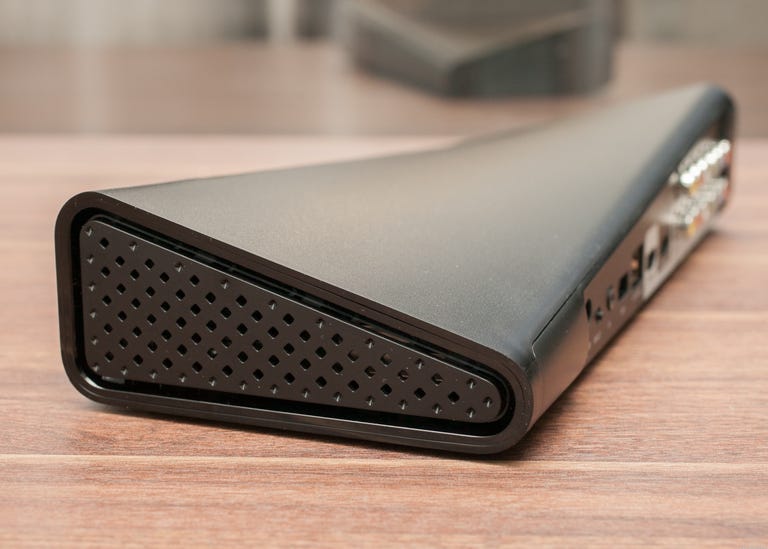 Why You Can Trust CNET
Why You Can Trust CNET Slingbox 500 review: Worth it for the Wi-Fi
The high-end Slingbox 500, which streams live TV -- and DVR recordings -- to most smartphones, tablets, and PCs, adds HDMI support, but it's only really worth it if you need the Wi-Fi connectivity.
Before there were "TV everywhere" apps, there was the Slingbox, a groundbreaking product that allowed you to stream your home TV signals to any PC or connected device on the planet, so long as you had the available bandwidth. After something of a hiatus -- there haven't been any new Sling products since 2008's Slingbox Pro-HD -- new Slingbox hardware was finally been released in fall 2012: the Slingbox 350 ($180) and the Slingbox 500 ($300, reviewed here).
The Good
The Bad
The Bottom Line
As with past Slingbox models, the boxes digitize video streams from your cable/satellite box (or DVR) and stream them in real time to a wide variety of devices: Windows PCs and Macs, iPads, iPhones, Android phones, Android tablets (including the Kindle Fire and Kindle Fire HD), Windows phones, and even some home devices, such as the Boxee Box, Logitech Revue, and WD TV Live. There's no monthly fee, but the mobile apps cost a pricey $14.99; that's down from the previously exorbitant $29.99 price, but it's still an added cost that should be reduced to zero -- or close to it. (The streaming software on the PC and Mac is via a free browser plug-in, and the home-streaming device apps are free as well.)
Both new Slingbox models add full 1080p video streaming, upping the lesser VGA and 720p resolutions found on the now-discontinued, 2008-era
Instead I'm going to focus on the key differences between the two boxes and talk about why you might spend the extra dough on the 500 -- or not.
Built-in Wi-Fi
In addition to the built-in IR blaster and streaming features found on the Slingbox 350, the $300 Slingbox 500 adds some unique new features. Probably the most important of the bunch is built-in Wi-Fi. Yes, this the first Slingbox to offer integrated Wi-Fi -- finally! If you have a router or an Ethernet connection available near where your Slingbox is set up, this won't be a big deal. But if you don't, it's obviously a key feature that would potentially make the 500 worth buying over the 350. Naturally you'll need a wireless network to tap into, but in my tests at home, setup was simple: you simply scan for your network, then type in its password (if it has one) using an onscreen virtual keyboard that you navigate with the included remote.
HDMI support
The 500 is also the first Slingbox to offer HDMI support (again: finally!), albeit with the usual caveat: if the broadcaster uses the most aggressive digital "flag," that channel or program won't be streamable via HDMI. For that reason, Sling recommends still connecting the component video input as well -- a "belt and suspenders" approach, a company rep told us.
I tested the 500 with Fios TV and had to use the component connection from my cable box to the Slingbox; the HDMI input on the Slingbox was rendered useless. However, I did use the HDMI output on the Slingbox to access the unit's menu system on my TV, as well as the new SlingProjector feature (see below).
SlingProjector
The Slingbox 500 offers AirPlay-like functionality the company calls SlingProjector, which makes it possible for iOS devices and Android phones to stream photos and self-shot videos from the handheld to the TV screen at the touch of a button. And because the Slingbox uses HDMI passthrough, it can share an input on your TV -- so if you activate the SlingProjector from your phone, the Slingbox "hijacks" the DVR input for the duration of your presentation, and then just flips back to the original programming when you're done. (Note: due to the nature of my setup, I ended up not using the HDMI passthrough, but I did use the HDMI output).
If you're an Apple TV owner and have iOS devices, the SlingProjector will duplicate a feature you already have. But it is nice that the feature supports Android devices. I tried it out with a Samsung Galaxy Note 2 and an iPhone 4S. In both cases, the feature worked as advertised. I simply tapped a little icon on the screen (just as you do with AirPlay) and my images and self-shot videos played on my TV. The video playback was smooth, too -- no stuttering or dropped frames.
Future features
On the back of both of the new Slingboxes you'll find a USB port. Right now, that port doesn't do anything and is reserved for additional features. A subsequent update is slated to make it possible to play USB-based digital video on the Slingbox 500, as well as sync videos and photos from a smartphone to the connected USB drive -- a process the company will call "SlingSync." Both features are currently slated to arrive in "early 2013."
Conclusion
Like the Slingbox 350, the Slingbox 500 is an excellent device for streaming video. It was easy to set up and worked smoothly in our tests, offering impressive video quality when streamed inside and outside the home.
That said, the Slingbox 500 is fairly pricey at $300 (list), so you should only choose it over the 350 if its extra features are important to you. While the SlingProjector and HDMI connectivity are nice bonuses, the real key for me is the Wi-Fi. I happen to have an Ethernet connection available to me where my AV components are located, so I'd be fine with the Slingbox 350, but if I didn't, I'd bite the bullet and spend the extra $100 or so to get the 500's wireless capabilities. I wouldn't necessarily be happy about it, but the HDMI and SlingProjector features help make the price jump a little more palatable.


